MARIANI’S
August 17, 2008
NEWSLETTER

Go for the Gold!
NEW! Click esquire.com
to go to my new column at Esquire Magazine.
ARCHIVE: Readers may now access
an
Archive of all past newsletters--each annotated--dating back to July,
2003, by simply clicking on www.johnmariani.com/archive
SUBSCRIBE AND
UN-SUBSCRIBE: You may subscribe anyone you wish
to this newsletter--free of charge--by
clicking here.

IMPORTANT ANNOUNCEMENT: There will be no issue of Mariani's Virtual Gourmet next
week, August 24, because Mariani will be on vacation. The next
issue will appear August 31. Have a
good end of summer!
~~~~~~~~~~~~~~~~
In
This Issue
ALL YOU CAN
EAT IN ALBUQUERQUE by John A. Curtas
NOTES FROM THE WINE CELLAR: The New Old Barbera by John Mariani
QUICK BYTES
~~~~~~~~~~~~
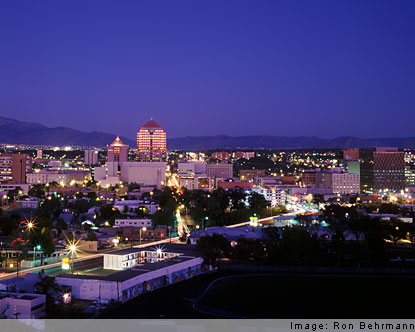 ALL-U-CAN-EAT
ALL-U-CAN-EATIN ALBUQUERQUE
by John A. Curtas
Albuquerque, New Mexico probably is not the first town that leaps to mind when you savor thoughts of fabulous, indigenous, American cuisine, but it should be. Throughout this capital of Native American-Mexican-Spanish food cultures is enough interesting and tasty grub to keep your palate interested and over-heated for weeks. And from a recent visit (my second in a year), I can confidently pronounce the food every bit as tasty and much less expensive as that in Santa Fe, an hour to the north.
The first thing I do upon arrival is to make a beeline to Duran’s Central Pharmacy (1815 Central N.W. ; 505-247-4141). Duran’s (below) is a small lunch counter tucked in the rear of the drugstore, and its all-female staff is justifiably famous for turning out some of the best green and red chile in Albuquerque. If you’ve never been to New Mexico, chile here means chile peppers, not the “chili” beef stew most associate with the word. The green and red you get here are thick, mildly spicy vegetable stews of those roasted chiles. As good as Duran’s versions are, what we come for is the carne adovada.
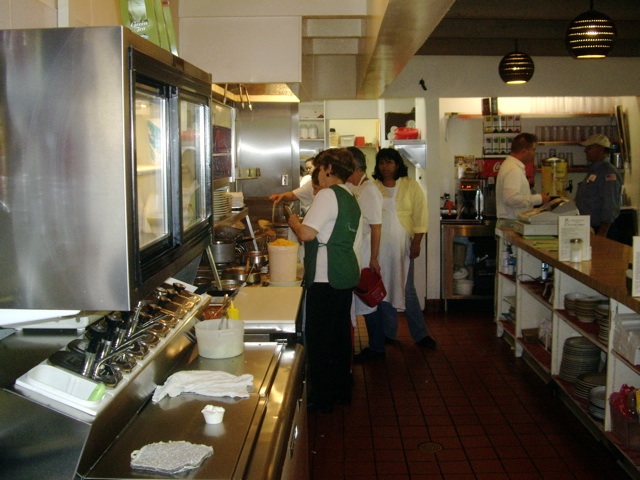
For the uninitiated, carne adovada is meat (usually pork) marinated in red New Mexican chiles, baked (the way purists insist) and then simmered in red chile sauce. The three-way infusion of chiles into the meat gives it a succulent, deep heat that other meat stews can’t touch. We time our visits to New Mexico to begin on Thursday because that’s the only day of the week carne adovada is served at Duran’s. We get ours with a couple of huge, thick, fresh made flour tortillas, and maybe a small bowl of green chile, just to make sure everything is right in the vegetarian chile universe. Duran’s has other New Mexican classics on its short menu, including stuffed sopaipillas (Wednesdays and Fridays only), and a "torpedo" (one of those giant tortillas filled with potatoes, chile and cheese), but it’s the carne adovada that has us licking our chops the moment the plane hits the ground.
After checking in o our casita at Casa de Sueños, within a short walk to Duran’s and Old Town Albuquerque, we decided one lunch isn’t enough, especially when Monroe’s green chile cheeseburgers are just down the street. Monroe’s (1520 Lomas Blvd; 505-242-1111) has been around since 1962. It’s not much to look at (like many of the superlative eateries in ABQ), but its low-key diner vibe masks a commitment to some serious cheeseburgers. A thick patty of good ground beef comes smothered in melted cheese with a heaping portion of house made green chile strips on the bun.
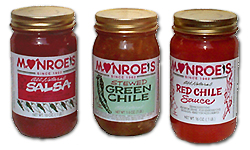 They
also make their red chile on-premises, and in a close contest, I had to
give it the nod over Duran’s for the intensity and depth of its
chile-ness. The sopaipillas
here are also outstanding, but we were disappointed in the
chile-infused fruit pies - which had too little of the expected jolt to
ring our chimes.
They
also make their red chile on-premises, and in a close contest, I had to
give it the nod over Duran’s for the intensity and depth of its
chile-ness. The sopaipillas
here are also outstanding, but we were disappointed in the
chile-infused fruit pies - which had too little of the expected jolt to
ring our chimes.No culinary tour of ABQ is complete without at least one stop at the Frontier (2400 Central SE; 505-266-0550). You might be a tad intimidated by the gargantuan barn-like space, long customer lines, and huge posted menu, but take a breath and you’ll figure it all out in no time. Those lines move mighty quickly because everyone knows they’ll be ordering a bowl of top-notch posole (green chile hominy stew), a huge breakfast burrito with hot green chile, and what may be the best sweet cinnamon roll on the planet. Well, perhaps everyone doesn’t order those, but we found them a perfect way to start the day, as have thousands of University of New Mexico staff and students since Frontier opened its doors across from the University back in the ‘70s. And the Frontier hasn’t closed for a minute since it opened, making it the perfect stop for late night carousers and early, early-birds.
Those seeking something a bit
more upscale, but still homey and authentic, should cruise out past
Kirtland AFB to Cervantes Restaurant
and Lounge (5801 Gibson SE;
505-262-2253). For 35 years Roberta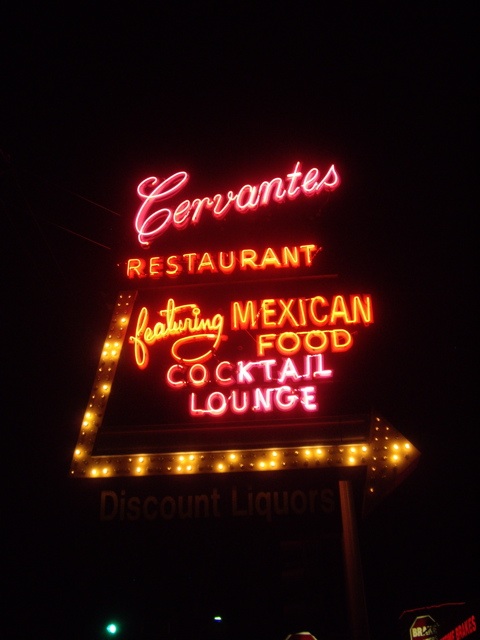 Finley has run this bastion of New Mexican cooking, focusing on the
green and red chile concoctions for which this region is famous.
Those chiles are from the same plant – what non-New Mexicans
call the Anaheim chile - and what is referred to in-state as the Hatch
or Mesilla Valley chile. The red is simply a riper version of the
green, but both deliver a deep, back of the throat heat that more
explosive peppers never approach. In terms of sensory resonance, it’s
like comparing a bass drum to a violin.
Finley has run this bastion of New Mexican cooking, focusing on the
green and red chile concoctions for which this region is famous.
Those chiles are from the same plant – what non-New Mexicans
call the Anaheim chile - and what is referred to in-state as the Hatch
or Mesilla Valley chile. The red is simply a riper version of the
green, but both deliver a deep, back of the throat heat that more
explosive peppers never approach. In terms of sensory resonance, it’s
like comparing a bass drum to a violin.
Cervantes bottles its own line of bottled green and red, and they
tasted just fine to us on the sopaipillas stuffed with well-spiced
ground beef, or with chunks of pork (green), or carne adovada (red). The
green chili cheeseburger was also spectacular. Served open-faced on a
thick flour tortilla, it comes smothered in chiles, and everyone at our
table gave it the nod over Monroe’s version, although we went back to
Monroe’s the next day and had a couple more of theirs just to make
sure. At Cervantes, as in every New Mexican restaurant in Albuquerque
I’ve tried, the rice and beans on the plate deserve savoring in their
own right, and put to shame what most Americans think of when they
order Mexican food. And the tortillas are generally larger, thicker and
more scarred with griddle marks than outsiders are used to. They are
served with butter melting on them, and you get as many as you want.
You might think that the holy trinity of these tortillas with green and
red (or “Christmas” if you ask for both) would get boring at meal after
meal, but the ingredients are so fresh, and so of-the-place you’re
eating them in, that palate fatigue is never an issue, and within a few
days you will be debating the relative merits of these locally famous
eateries like a native.
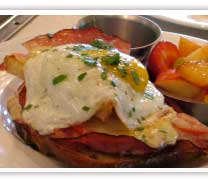 Of the new guard of swankier joints, The Grove Café and Market (600
Central Avenue SE; 505-248-9800) serves
an upscale mix of artisanal breakfast items (left), a truly stellar croque
madame, and a number of in-house baked goods that make it the
go-to
breakfast place in town. Every table we saw seemed to have the house
specialty – an old-fashioned English muffin with Heidi’s Organic Jam –
on it, so we took the plunge and found it perfect in all respects,
although made to American (read: huge) proportions. Located right on
the old Route 66, organic is the watchword here, and even the delicious
pancakes with crème fraîche trumpet the provenance of the
ingredients that go into them.
Of the new guard of swankier joints, The Grove Café and Market (600
Central Avenue SE; 505-248-9800) serves
an upscale mix of artisanal breakfast items (left), a truly stellar croque
madame, and a number of in-house baked goods that make it the
go-to
breakfast place in town. Every table we saw seemed to have the house
specialty – an old-fashioned English muffin with Heidi’s Organic Jam –
on it, so we took the plunge and found it perfect in all respects,
although made to American (read: huge) proportions. Located right on
the old Route 66, organic is the watchword here, and even the delicious
pancakes with crème fraîche trumpet the provenance of the
ingredients that go into them.
For our final meal, our native guide
(my son Hugh Alexander Curtas, UNM Class of ’08) led us to a tiny,
obscure
strip mall that didn’t appear to house any sort of food service even as
we were standing in front of it. They then led us to one of those
standard metal-glass doors that usually lead to a chiropractor’s office
or a muffler shop. Once inside, however, we entered the world of Chef du Jour (119 San Pasquale Avenue
SW; 505-247-8998) and knew we weren’t in traditional
Albuquerque anymore. The spare, tasteful dining room was created by
Chef Jennifer James - a local hero who sources local products and riffs
on them daily with a menu that doesn’t know how to repeat itself.
Our meal began with a bright, fresh chilled
pea soup with mint, followed by mussels in a spicy tomato broth. From
there we filled up on what the menu called “fillers” and the rest of
the world calls main courses of pasta with herb butter and spring
vegetables, seared scallops in a carrot broth, a perfect rack of
(local) lamb with hazelnut mint pesto and smashed peas, and a pork
t-bone with black beans, rice, and house-made banana ketchup. The
ketchup was so good I asked for three refills, and wondered aloud why
they just don’t rename the place the Banana Ketchup Cafe. Like the rest
of the meal, desserts were simple, sophisticated and satisfying with
the chocolate-Nutella-banana crêpe and the root beer float – made
with
house-made ice cream and local root beer (naturally) - the clear
standouts. The wine list is very short and limited, but very reasonably
priced.
While we were there in May, a USA Today story came out rating
the most expensive and inexpensive places in America to vacation.
Albuquerque was ranked #1 as the best budget vacation spot in the
country. Eat at any of these restaurants and you will see why. In all
of them (except Chef du Jour), you can indulge in New Mexican’s finest
cuisine for less than $40/couple. Dinner for two at Chef du Jour (one
of the more expensive places in town) will run around $120 for two,
with a modest wine.
Aside from the price though, what is
impressive about Albuquerque is a palpable commitment to the indigenous
cuisine of the area, and to featuring local products throughout its
food chain. From local artisanal beers, to the chile-infused fudge of The Candy Lady (524 Romero NW; 505-243-6239, 800-214-7731),
to the serious wines of Casa Rondena
Winery (733 Chavez Road,
Los Ranchos de Albuquerque), to the cult of the green chile
cheeseburger; there is a feast of good eats along this section of the
Rio Grande, in a town that takes its food and drink very seriously.
~~~~~~~~~~~~~~~~~~~~~~~~~~~
NEW YORK CORNER
For Terrific Indian Food—very cheap!—
Head for Jackson Heights
by John Mariani
Manhattan
may well claim to have the most refined—and pricey—Indian restaurants,
like Dawat, Tamarind, and Chola—but the borough of Queens’s Jackson
Heights neighborhood isn’t nicknamed “Little India” for nothing.
Here, over an eight square block area, easily
reached by taxi or subway, is where you’ll find more regional downhome
cooking from the subcontinent and at far cheaper prices. The
neighborhood teems with immigrants from Mumbai, Goa, New Delhi,
Bangladesh, and Pakistan, and the streets are lined with kebab shops,
fast food eateries, sweet shops, and casual restaurants whose
specialties reflect their owners’ provenance.
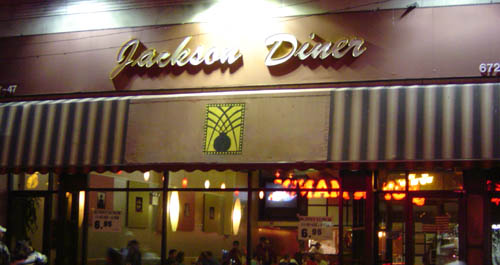 Stores
sell saris set on old mannequins that look more like Alan Ladd and
Veronica Lake than they do Asians. Movie theaters show all the new
Bollywood films and music/video stores sell thousands of Bollywood CDs
and DVDs. I’ve never seen more gold and silver shops outside of
Manhattan’s Jewelry District, and the neighborhood law offices
advertise their expertise with “Immigration & All Legal Matters.”
Stores
sell saris set on old mannequins that look more like Alan Ladd and
Veronica Lake than they do Asians. Movie theaters show all the new
Bollywood films and music/video stores sell thousands of Bollywood CDs
and DVDs. I’ve never seen more gold and silver shops outside of
Manhattan’s Jewelry District, and the neighborhood law offices
advertise their expertise with “Immigration & All Legal Matters.”
Stepping out of a taxi or up from the
Roosevelt Avenue F train stop, you are immediately hit with the aromas
of cardamom, coriander, ginger, saffron, and cinnamon, wafted from
restaurant doorways and apartment windows. In the restaurants young
Indians, engrossed in their I-pods, scarf up rice dishes and
curries. People are lined up outside shops that specialize in
stuffed, deep-fried samosa pastries, and in the sweet shops wide-eyed
children point to jalebi candies, carrot halwa, and pistachio-flecked
cheese dumplings.
One of the long-running, stand-out restaurants
in Little India is the curiously named Jackson Diner (37-47 74th
Street; 718-672-1232), which took over an old diner here in
1980, and has been a destination for northern Indian food aficionados
ever since. It’s a huge place with high ceilings, tables with placemats
and paper napkins, and a full bar. Service is perfunctory, at
best, and they take only cash.
Somehow I suspect that if Al Pacino or Jay-Z
walked in here the owners wouldn’t notice; if, though, a Bollywood star
like Arjun Rampal or Aishwarya Rai dropped by, the place would become
pandemonium.
So you sit down, order a Kingfisher beer, and
open a menu where the most expensive item is the “tandoori deluxe”—a
big platter of kababs, lamb chops, prawn and fish for $23.95. Start off
with the wonderful samosas stuffed with spiced peas and potatoes
($3.95), or the paneer pakora ($6.95), cheese fritters stuffed with
mint. By all means get a dosa ($9)—the fragile and crisp,
foot-long rice-and-bean flour crepes stuffed with coconut and potato.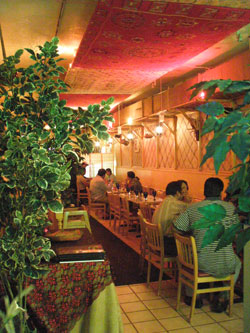
This is food to be shared and taken home, and
at these prices you might as well over-order. The malai kofta ($11.50)
are cheese-and-vegetable croquettes simmered in a very rich creamy
curry sauce, while sag paneer ($11.50) is a savory, complex stew of
spinach, potatoes, and cheese. With these you pull off pieces of
tandoor-cooked onion kulcha that is sweet, yeasty, and seared with a
little char.
Around
the corner and up a couple of blocks is a busy storefront eatery that
puts its best dish in their name—Deshi Biryani (75-18 37th Avenue; 718-803-6232), a
Bengali restaurant whose recipes supposedly derive from the owners’
grandmother, and the biryani rice dishes have built an enviable
reputation around the neighborhood.
Deshi Biryani (right) doesn’t look like much—a
narrow room with bamboo screens and hats, tile floors, and, up front, a
couple of sofas where you can wait for a table. Service here is
not exactly a model of efficiency, and the food takes a while to come
out of the kitchen.
When it does, you will be very happy if you’ve
ordered the house specialty, a lavish portion of Kachi Biryani
($10.99), made with extremely tender goat’s meat that has absorbed all
the flavors, saffron, and myriad spices of a broth that also suffuses
the fragrant basmati rice.
The samosa ($3.99) and the dim aloo chop
($4.99), filled with potato, chilies, hard-boiled egg, and spices, are
enormous and delicious. And the boti skewered dishes ($12.99) are
equally generous—a platter of vegetables and salad topped with plump
kababs of beef marinated in yogurt and papaya, then cooked for hours.
You’re not likely to want dessert in either of
these restaurants, and if you bring food home on the subway, be
prepared to have people stare at you with longing as those Indian
spices perfume the air.
NOTES FROM THE WINE CELLAR
The New Old Barbera by John Mariani
Barbera
is Italy’s third most planted red grape, and that ain’t good.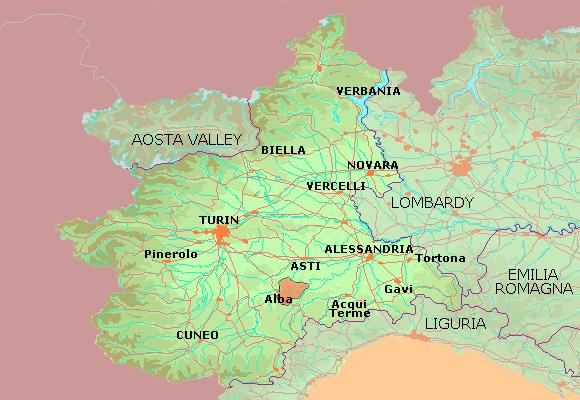
Too much
for too long has given this Piedmontese wine a decidedly second-class
image, especially when compared with the regions “noble” Barolos and
Barbarescos, made from the nebbiolo grape. Barbera still constitutes
more than the 50 percent of the DOC red wine made in Piedmont.
But barbera’s getting better, particularly in
the zones of Asti and Alba, which tend to be warmer, allowing for
better ripening. Acidity has always been high in barbera, and
alcohol low, 11 to 12 percent. Until recently it would be difficult to
describe a “typical” barbera style, except as pleasant, acidic wines,
with low tannins, that go well with the foods of the region—boiled
meats, stuffed pastas, and risotto cooked with red wine.
Good examples have an earthy quality
about them; bad ones have very little flavor at all. But hundreds of
years of shrugging tradition were bucked when, in the 1970s, Giacomo
Bologna began restricting grape yield and put his barberas into small
oak casks, resulting in bigger, more intense examples. His Bricco
dell’Uccellone is in fact considered one of Italy’s finest
wines, with
recent vintages selling for $50-$70, though I’m not sure what a bottle
of Bricco will tell you about barbera itself.
Yet as so often happens among Italian
vintners, once a colleague hits the big money, they begin to believe
their wines should cost in the same range, with several wholly mediocre
bottlings selling for $40 and up.
I recently tasted a wide variety of barberas from the Alba region with
a wide variety of foods, none particularly complex. The acid
component is always front and center on the palate upon first sip—this
is not a wine to have as an aperitif—and the style and complexity of
most sampled did not develop until I had them with food. What’s
significant is that all were at least 13 percent alcohol, two at a
whopping 14.5, indicative of how better grapes lead to more intensity.
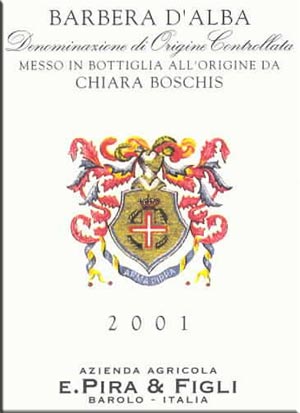 Giovanni
Rosso 2005 ($20) was more
tannic than I expected, though the acids were also pronounced. It took
an hour or so to loosen up, but it never really mellowed out. Perhaps
it will develop over the next year, but I couldn’t discern its charms
on an August evening with sautéed chicken breast.
Giovanni
Rosso 2005 ($20) was more
tannic than I expected, though the acids were also pronounced. It took
an hour or so to loosen up, but it never really mellowed out. Perhaps
it will develop over the next year, but I couldn’t discern its charms
on an August evening with sautéed chicken breast.
Attilio
Ghisolfi Barbera Vigna Lisi
D’Alba 2004 ($24) was a year older than the Giovanni Rosso but
it had
no nose and tasted quite bland—a wine I thought should cost about
$10. Then, the next day at lunch, I tasted it again and it had
improved somewhat, exposing a richer content and pleasing cherry
flavors.
Giacomo Conterno is
one of the
best-known Piedmontese producers (not to be confused with another fine
vintner, Aldo Conterno), and his 2005 Barbera d’Alba ($47) had quite a
vegetal bouquet, blossoming into a delicious, medium-bodied wine with
some oakiness and good tannins. If not a blissful wine, it is a good
modern example of the varietal from a tradition-minded producer.
E.
Pira & Figli Barbera d’Alba 2005
($26) was a happy surprise, especially at that very reasonable
price. It was very fragrant right from the first sniff, unusually
floral for a barbera, with a far better balance of acid and tannin than
other examples tried. This is an Italian red wine I could drink again
and again.
Mascarello
Giuseppe e Figlio 2004 ($50)
was even more enjoyable, a big, mouth-filling wine that was warm and
velvety on the palate, filling the mouth with fruit and acid in fine
equilibrium. Worth $50? Well, it’s the equal of Bricco dell’Uccellone,
which usually costs somewhat more. Paterfamilias Mauro Mascarello (right) is headed for the limelight
with this wine.
One of the most respected Piedmontese
winemakers and consultants is Renato
Ratti, so I expected to find his Torriglione big and
bountiful with fruit. Amazingly, it was a
2006—less than two years old—and cost only $19, yet it brimmed with
fruit and had the faint, farm-like back taste I’d missed in so many
other examples. A fine wine at a very good price.
Seghesio
($17) was also a 2006, and its
freshness and bright fruit was on its side too. It had a sumptuous
bouquet, followed by a lush, big red wine style, very easy to drink,
perfect with the thick cheeseburger I enjoyed it with.
Maybe, just maybe, barberas are better when
they are younger. As I thought about this, I remembered those times in
Piedmont when I was eating a plate of agnolotti in broth,
accompanied by a rustic, simple barbera d’Alba. I was very contented
then and didn’t want to be impressed. But now, having gone
through a slew of modern examples, I will expect better.
~~~~~~~~~~~~~~~~~~~~~~~~~~~~~~~~~~~~~~~~~~~~~~~~
 Maybe It's Your Breath!
Maybe It's Your Breath!
“Generally when I’ve occupied the only table during the lunchtime service, my arrival is greeted with the sort of jollity usually reserved for when the plague ship ties up in port.”—Jay Rayner, A review of “The Old Vicarage,” The Observer (June 15).
SO THAT'S WHAT THE OTHER 58 % IS!
In Cincinnati, Fredric J. Baur, who designed the Pringles potato crisp packaging system, died at the age of 89, requesting that a portion of his ashes be buried in one of the cans in his grave in Springfield Township, with the rest of his remains placed in an urn buried along with the can. . . MORE PRINGLES NEWS: Britain’s High Court ruled that Pringles are not a snack and thus not subject to sales tax, because the judge found that only 42 percent of Pringles were made of potato.

WE THOUGHT THE
WORD WAS "BAO WAO"
Dog meat has been struck from the menus of officially designated Olympic restaurants in Beijing, according to Xinhua News Agency reported Friday. Waiters and waitresses are supposed to "patiently" suggest other options to diners who order dog, which in Chinese is called "xiangrou," ("fragrant meat").
* During Open House Mondays at Chicago's Pops For Champagne, created by
Executive Chef Andrew Brochu, and Wine Director W. Craig Cooper, offers
a special menu paired with Champagne with various small plates, 3
courses paired with a glass of Laurent-Perrier Champagne . $70
pp. Visit www.popsforchampagne.com.
* On Aug. 20 New Haven
Food & Wine Festival featuring Wolf Blass Wines will be held
at Pilot Pen Tennis, with 19 of New Haven’s restaurants, in addition to
chef, cookbook author and teacher, Jacques Pépin. The
event will also include a wine tasting with wine professionals from
Australia’s award-winning Wolf Blass wines. Visit:
http://www.infonewhaven.com/eat.
* On Aug. 22 in Schaumburg, IL, Shaw’s Crab House is
hosting
its 6th Annual Clambake Dinner on the restaurant’s outdoor patio at
$49.95; Call 847-517-2722; www.shawscrabhouse.com.
* From Aug. 23-Sept. 7 Tony Mantuano of
Chicago’s Spiaggia will
showcase recipes from Wine Bar Food at the U.S. Open. Call
312.280.2750 for info.
* On Aug. 23 in Beverly Hills, Two Rodeo and LearnAboutWine present STARS of
California, with 40 top-flight wines from California, incl. a special
cellar selection from Insignia 1997. A portion of proceeds benefit the
T.J. Martell Foundation.Call (310) 451-7600; $125 in advance;
$140 at the door; www.learnaboutwine.com; www.tworodeo.com.
* On Aug. 28, Tom Bulleit, President and Founder of
Bulleit Bourbon, will
host a dinner at Bourbon House
in New Orleans by Chef Darin Nesbit accompanied by unique Bulleit
Bourbon cocktails. $75 pp/ Call 504.284.1831 or nobs@bourbonhouse.com.
* On Sept. 5 As part of it's 25th anniversary
celebration, Paumanok Vineyards
on Long Island, NY, holds a “Sunset at the Vineyard Tribute to Dick
Sudhalter” with jazz by Marty Grosz and Destiny. $100
pp. Call 631-722-8800 or email info@paumanok.com. Proceed to Mary
Manning Walsh Nursing Home.
* Chef Jean-Georges
Vongerichten now offers a "Culinary Master Course" at Trump
International Hotel & Towel New York incl. a 2-hour private
cooking lesson in the kitchen of his namesake restaurant, 3
nights in an Executive Park View Suites, 3-course dinner for two with a
bottle of Champagne, Breakfast for two daily at Nougatine, and signed
copy of Asian Flavors of Jean-Georges. $8,999. Visit www.trumpintl.com.
Everett Potter's Travel Report:

~~~~~~~~~~~~~~~~~~~~~~~~~~~~~~~~~~~~~~~~~~~~~~~~~~~~~~~~~~~~~~~~~~~~~~~~~~
Eating Las Vegas is the new on-line site for Virtual Gourmet contrinbutor John A. Curtas., who since 1995 has been commenting on the Las Vegas food scene and reviewing restaurants for Nevada Public Radio. He is also the restaurant critic for KLAS TV, Channel 8 in Las Vegas, and his past reviews can be accessed at KNPR.org. Click on the logo below to go directly to his site.
~~~~~~~~~~~~~~~~~~~~~~~~~~~~~~~~~~~~~~~~~~~~~~~~~~~~~~~~~~~~~~~~~~~~~~~~~~~
Tennis Resorts Online: A Critical Guide to the World's Best Tennis Resorts and Tennis Camps, published by ROGER COX, who has spent more than two decades writing about tennis travel, including a 17-year stretch for Tennis magazine. He has also written for Arthur Frommer's Budget Travel, New York Magazine, Travel & Leisure, Esquire, Money, USTA Magazine, Men's Journal, and The Robb Report. He has authored two books-The World's Best Tennis Vacations (Stephen Greene Press/Viking Penguin, 1990) and The Best Places to Stay in the Rockies (Houghton Mifflin, 1992 & 1994), and the Melbourne (Australia) chapter to the Wall Street Journal Business Guide to Cities of the Pacific Rim (Fodor's Travel Guides, 1991). THIS WEEK: A Report on The Four Seasons Jackson Hole. Click on the logo below to go to the site.

~~~~~~~~~~~~~~~~~~~~~~~~~~~~~~~~~~~~~~~~~~~~~~~~~~~~~~~~~~~~~~~~~~~~~~~~~
MARIANI'S VIRTUAL GOURMET NEWSLETTER is published weekly. Editor/Publisher: John Mariani.
Contributing Writers: Robert Mariani,
Naomi
Kooker, Suzanne Wright, John A. Curtas, Edward Brivio, Mort
Hochstein, Suzanne Wright. Contributing
Photographers: Galina Stepanoff-Dargery, Bobby Pirillo. Technical
Advisor: Gerry McLoughlin.
Any of John Mariani's books below
may be ordered from amazon.com by clicking on the cover image.
 My
newest book, written with my brother Robert Mariani, is a memoir of our
years growing up in the My
newest book, written with my brother Robert Mariani, is a memoir of our
years growing up in the For those of you who don't think of the Robert and I think you'll enjoy this very personal look at our --John Mariani |
 |
 |
 |
 |
 |
 |
© copyright John Mariani 2008
